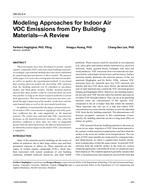Description
Physical models have been developed to predict volatile organic compound (VOC) emissions from building materials. Accordingly, experimental methods have also been established for measuring input parameters to these models. The purpose of this paper is to review the existing material emission models, as well as to analyze the experimental methods. It was found that existing physical models for describing VOC emission from dry building material can be classified as one-phase models and multi-phase models. Further detailed analysis showed that these models could be converted from one form into another as long as the linear sorption isotherm is used in both approaches. This inter-model conversion has been validated through comparison of the models’ predictions with the experimental data as well as the inter-model prediction.
In addition, it was found that the impact of material porosity on indoor VOC concentration is significant only if the partition coefficient has the same magnitude as the material porosity. The results also indicated that VOC concentration increases as the material porosity increases. Also, when the partition coefficient is more than one order of magnitude greater than the material porosity, the effect of material porosity diminishes and its impact on the indoor VOC concentration is negligible.
Units: SI
Citation: Symposium, ASHRAE Transactions, vol. 111, pt. 1, Orlando 2005
Product Details
- Published:
- 2005
- Number of Pages:
- 11
- File Size:
- 1 file , 1.5 MB
- Product Code(s):
- D-25552




